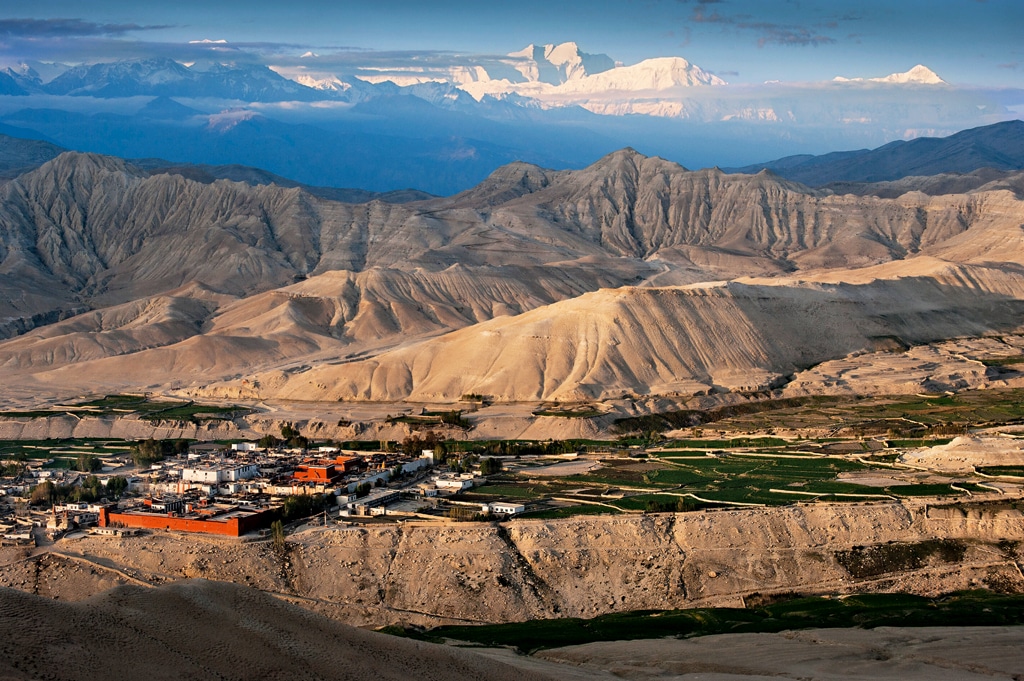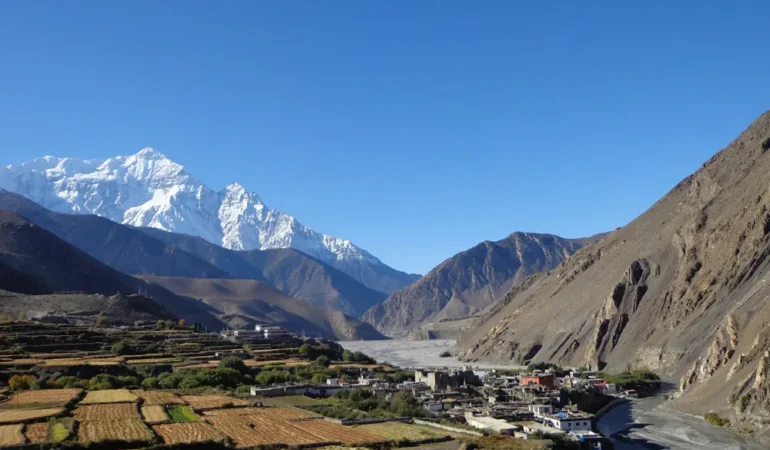Trip Overview

Upper Mustang, once a forbidden kingdom, was opened to trekkers in 1992. Its isolation has preserved a rich Tibetan culture, evident in its monasteries, caves, and traditional villages. The trek typically starts from Jomsom, following the Kali Gandaki River through arid landscapes to the walled city of Lo Manthang. Trekkers can witness ancient monasteries, unique rock formations, and panoramic views of the Annapurna and Dhaulagiri ranges.
🗺️ Trek Highlights
-
Lo Manthang: The ancient capital, featuring a royal palace and monasteries like Thubchen and Jampa.
-
Chhoser Caves: Centuries-old cave dwellings carved into cliff faces.
-
Tiji Festival: A vibrant three-day festival in Lo Manthang, celebrating the victory of good over evil.
-
Kali Gandaki Gorge: The world’s deepest gorge, offering dramatic landscapes.
Panoramic Mountain Views: Stunning vistas of Annapurna, Dhaulagiri, and Nilgiri peaks.
🧭 Trekking Route
The standard route begins with a flight from Pokhara to Jomsom, followed by treks through Kagbeni, Chele, Syanboche, and Ghami, reaching Lo Manthang. The return journey often takes a different path, passing through Dhakmar and Samar before returning to Jomsom. The trek covers approximately 160 km over 12-14 days, with altitudes ranging from 2,700m to 4,200m.
🛂 Permits and Regulations
Upper Mustang is a restricted area, requiring special permits:
-
Restricted Area Permit: USD 500 per person for the first 10 days, plus USD 50 for each additional day.
-
Annapurna Conservation Area Permit (ACAP): Approximately USD 30 per person.
Trekkers must be in groups of at least two and accompanied by a licensed guide. Solo trekking is prohibited.
🏨 Accommodation and Meals
Teahouses and lodges along the route offer basic accommodations with shared facilities. Meals typically include Nepali dishes like dal bhat, as well as Tibetan bread, noodles, and soups. While options are limited, the hospitality is warm and welcoming.https://highpasstreks.com/
📅 Best Time to Trek
-
Spring (March to May): Clear skies, blooming flora, and the Tiji Festival in May.
-
Autumn (September to November): Stable weather and excellent visibility.
Due to its location in the rain shadow, Upper Mustang is also suitable for monsoon trekking (June to August).
💰 Cost Overview
The total cost varies based on services and group size, ranging from USD 1,700 to USD 3,000 per person. This includes permits, guide and porter fees, accommodations, meals, and transportation. Additional expenses may include travel insurance, personal gear, and tips.
🧳 Packing Essentials
-
-
Warm clothing for varying temperatures.
-
Sturdy trekking boots.
-
Sleeping bag suitable for cold nights.
-
Water purification tablets or filters.
-
Sunscreen, sunglasses, and a hat.
First aid kit and personal medications.
⚠️ Health and Safety
While the risk of altitude sickness is lower compared to higher-altitude treks, acclimatization is essential. Trekkers should maintain a steady pace, stay hydrated, and be aware of symptoms like headaches or dizziness. Travel insurance covering high-altitude trekking and emergency evacuation is strongly recommended.
🏔️ Altitude and Acclimatization
Although the elevations in Upper Mustang are lower compared to other high-altitude treks in Nepal, altitude sickness can still be a concern. Trekkers ascend to altitudes exceeding 3,800 meters (12,467 feet), which can pose the risk of altitude sickness.https://highpasstreks.com/
Tips to mitigate altitude-related issues:
-
-
-
Acclimatization: Include rest days in your itinerary to allow your body to adjust.
-
Hydration: Drink plenty of water to stay hydrated.
-
Pace: Maintain a steady and manageable trekking pace.
Awareness: Be vigilant for symptoms of altitude sickness, such as headaches, nausea, or dizziness, and descend if symptoms worsen.https://highpasstreks.com/
🏞️ Terrain and Trail Conditions
The trail encompasses a variety of terrains:
-
Wide paths: Many sections are broad and can accommodate vehicles.
-
Narrow and steep segments: Some parts involve narrow trails with steep ascents and descents.
-
Rocky and uneven surfaces: Expect rocky paths and occasional river crossings.
The terrain in Upper Mustang is not too difficult. The walking hours on average is between 5-7 hours per day.
🌬️ Climate and Weather Challenges
Upper Mustang lies in the rain shadow of the Himalayas, resulting in a dry and arid climate. However, trekkers should be prepared for:
-
Temperature fluctuations: Warm days and cold nights are common.
-
Strong winds: Especially prevalent in the afternoons.
-
Limited water sources: Carry sufficient water and purification methods.
The region is dry and often windy, so water sources are limited, and the temperature can change quickly.https://highpasstreks.com/
🧠 Mental and Physical Preparation
While the trek doesn’t demand technical skills, mental resilience and physical preparation are crucial:
-
Physical training: Engage in cardio exercises like hiking, running, or cycling before the trek.
-
Mental readiness: Be prepared for basic accommodations and limited amenities.
-
Flexibility: Adapt to changing weather conditions and trail challenges.
Despite all the desert-like, rough, steep terrains, the Upper Mustang Trek difficulty is considered easy, along with its ancient cultural experience.
Summary
-
Difficulty: Moderate
-
Highest Point: Lo Manthang at ~3,850 meters (12,631 feet)
-
Trekking Duration: Typically 12-15 days
-
Daily Trekking Hours: 5 to 7 hours
-
Best Seasons: Spring (March-May) and Autumn (September-November)https://highpasstreks.com/
With adequate preparation, the Upper Mustang Trek offers a rewarding experience, combining cultural immersion with the unique landscapes of Nepal’s hidden kingdom.












